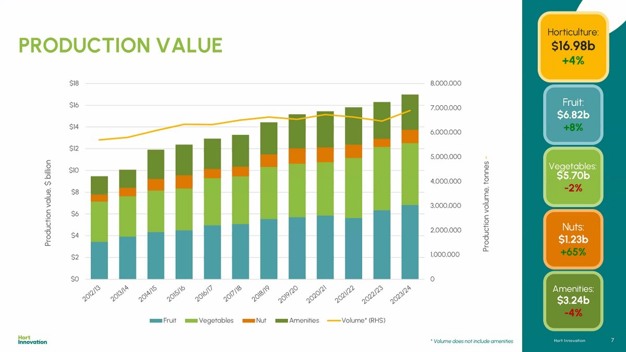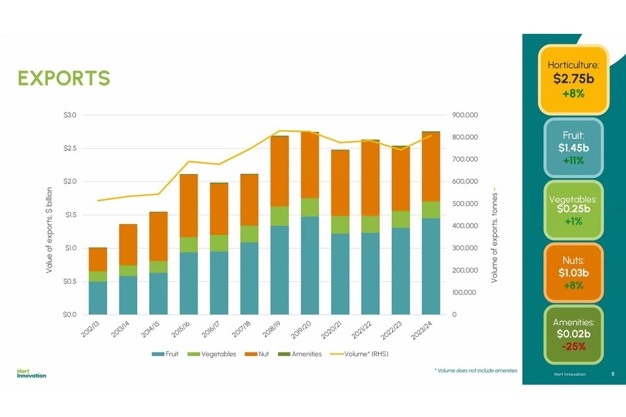Australian horticulture has achieved record production values, passing $17 billion dollars in the 2023-24 financial year. According to Hort Innovation's annual statistics handbook, this is a 4.3 per cent increase compared to the year prior - and exports played a major role.
The 11th edition of the Australian Horticulture Statistics Handbook covers more than 75 different horticulture lines across the country and Hort Innovation CEO Brett Fifield says that the figures come despite Australian growers continuing to suffer record highs when it comes to input costs, and have recently felt the impacts of biosecurity incursions and national disasters.
"Our vision is for a profitable and sustainable sector, built on innovation," Mr Fifield said during the online launch of the report. "Today the news is positive, Australian horticulture is well on the way to becoming a $20 billion sector by 2030. The fruit sector has led the growth with production values growing by almost half a billion dollars (7.8%) to reach a value of $6.82 billion. This was driven by strong performances in berries, citrus, and bananas. Export growth is a critical element to our viability reached a record high of almost $3 billion. This has been driven by fruit exports, particularly avocados and citrus. Our vegetable sector continues to strengthen; while vegetable volumes increased, overall vegetable production value declined by 2.4 per cent."

Hort Innovation's Head of Industry Insights, Lucy Noble, added that the horticulture sector is on a real growth trajectory, and reaching the impressive $17 billion is a testament to the resilience of the sector, given the challenges.
"The average annual growth rate, when compounded annually, is 5.5 per cent - and that's a significant achievement," she said. "This year saw farmgate value grow with around $ 700 million added over the last year. This was driven by large increases in fruit, which saw production values increase by nearly half a billion dollars (8%) to reach $6.8 billion. The value of the hort sector was also supported by the recovery of nuts, which came back off a difficult 2022-23 season with production increasing by nearly half a billion dollars also, to reach $1.23 billion."
However, Ms Noble points out that it wasn't a one-size-fits-all story, and despite the growth across fruit and nut lines pushing up the overall value of the industry, the vegetable sector was slightly down with values declining by 2.4 per cent to come back to $5.7 billion.

Overall, production volumes increased by 7 per cent in the last year, and Freshlogic's Managing Director, Martin Kneebone, whose company provided the data for the handbook, explains that there has been a recovery across several categories.
"That lift translated into higher value and was greater than the adverse effects of the categories that were down," he said. "The movers were tomatoes, avocados, summer fruit, and berries - and they more than compensated for the lower value categories. That has summed up what has happened over the years; we have times when some of the 75 different groups are up or down, but there's no one-size-fits-all. We will get different conditions and different exposure to export markets. That seems to be holding up a resilient period of growth over time - and that's what has happened over the past year - particularly due to increments of production recovering and stronger volumes."
Fresh horticulture exports also increased, according to the handbook, with a record high value of $2.75 billion which was driven by strong fruit exports, particularly in citrus and avocados. This continues the strong export growth trajectory that has been experienced over the past few years for the industry. While the value of fresh horticulture exports rose overall, there were some outliers, with table grapes declining 19 per cent in volume and values down 14 per cent.

"If you look at the bigger categories, there are seven that are at a higher level, above 40,000 tonnes per annum in exports," Mr Kneebone said. "Six of those categories saw stronger volumes that held or had stronger prices. That is a positive and more than compensated for the adverse season for grapes, where production figures were affected in terms of lower yield. There's a second tier of categories generating export volumes, led by avocados, melons, and summerfruit that is encouragingly evolving and heading towards that higher level. In most categories, prices are holding as the volume lifts, with some exceptions. Encouragingly, this confirms market acceptance of higher quality products and value from a product of Australian origin. It is over a wide enough range of categories to draw that conclusion, and it's a great platform for more exports."
Australia's export marketing has been a real  strength and a driver of growth, according to Mr Kneebone, with incremental values still being generated domestically through things like smaller portions, waste management, and more shopping trips. It means that fruit and vegetable lines have been able to be purchased by more households, which has led to greater value, in addition to population growth which he says is a great stimulus to demand; one per cent population increase translates to over 35,000 tonnes demand per year - and over $120 million wholesale value - and the sector is running at twice that.
strength and a driver of growth, according to Mr Kneebone, with incremental values still being generated domestically through things like smaller portions, waste management, and more shopping trips. It means that fruit and vegetable lines have been able to be purchased by more households, which has led to greater value, in addition to population growth which he says is a great stimulus to demand; one per cent population increase translates to over 35,000 tonnes demand per year - and over $120 million wholesale value - and the sector is running at twice that.
To read the full Australian Horticulture Statistics Handbook: click here
For more information
Hort Innovation
Phone: +61 2 8295 2300
info@horticulture.com.au
www.horticulture.com.au
